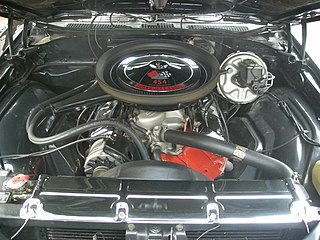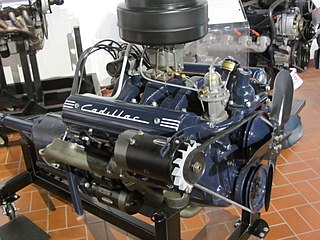
The General Motors LS-based small-block engines are a family of V8 and V6 engines designed and manufactured by American automotive company General Motors. First introduced in 1997, the family is a continuation of the earlier Chevrolet small-block engine, of which over 100 million have been produced altogether, and is also considered to be one of the most popular V8 engines ever. Spanning three generations, a new, sixth generation is expected to enter production soon. Various small-block V8s were and still are available as crate engines.

The Chevrolet "big block" engine is a term for a series of large-displacement, naturally-aspirated, 90°, overhead valve, gasoline-powered, V-8 engines; that were developed and produced by the Chevrolet Division of General Motors, from the 1950s until present.

The Chevrolet small-block engine is a series of gasoline-powered, V-8 automobile engines, produced by the Chevrolet division of General Motors between 1954 and 2003, using the same basic engine block. Referred to as a "small-block" for its size relative to the physically much larger Chevrolet big-block engines, the small block family spanned from 262 cu in (4.3 L) to 400 cu in (6.6 L) in displacement. Engineer Ed Cole is credited with leading the design for this engine. The engine block and cylinder heads were cast at Saginaw Metal Casting Operations in Saginaw, Michigan.
The Chevrolet Stovebolt engine is a straight-six engine made in two versions between 1929 and 1962 by the Chevrolet Division of General Motors. It replaced the company's 171-cubic-inch (2.8 L) inline-four as their sole engine offering from 1929 through 1954, and was the company's base engine starting in 1955 when it added the small block V8 to the lineup. It was completely phased out in North America by 1962, but GM continued to build it in Brazil until 1979. It was replaced by the Chevrolet Turbo-Thrift engine.

The High Value engine family from General Motors is a group of cam-in-block or "overhead valve" V6 engines. They use the same 60° vee bank as the 60° V6 family they are based on, but the new 99 mm (3.90 in) bore required offsetting the bores by 1.5 mm (0.059 in) away from the engine centerline. These engines are the first cam in block engines to implement variable valve timing, and won the 2006 Breakthrough Award from Popular Mechanics for this innovation. For the 2007 model year, the 3900 engine features optional displacement on demand or "Active Fuel Management" which deactivates a bank of cylinders under light load to increase highway fuel economy. It was rumored GM would produce a 3-valve design, but that never came to be. These engines were produced primarily at the GM factory in Tonawanda, New York and at the Ramos Arizpe engine plant in Mexico. The assembly line for this engine was manufactured by Hirata Corporation at their powertrain facility in Kumamoto, Japan.

The Pontiac LeMans is a model name that was applied to subcompact- and intermediate-sized automobiles marketed by Pontiac from 1961 to 1981 and 1988-1993 model years. Originally a trim upgrade based on the Tempest, it became a separate model. In 1964 the Tempest was available with an optional GTO package that later became a separate model, the Pontiac GTO, muscle car. 1970 introduced the GT-37 package.

The term Cadillac V8 may refer to any of a number of V8 engines produced by the Cadillac Division of General Motors since it pioneered the first such mass-produced engine in 1914.

In automotive engineering a multi-valve or multivalve engine is one where each cylinder has more than two valves. A multi-valve engine has better breathing and may be able to operate at higher revolutions per minute (RPM) than a two-valve engine, delivering more power.

The Hispano-Suiza 8 was a water-cooled V8 SOHC aero engine introduced by Hispano-Suiza in 1914, and was the most commonly used liquid-cooled engine in the aircraft of the Entente Powers during the First World War. The original Hispano-Suiza 8A was rated at 140 hp (100 kW) and the later, larger displacement Hispano-Suiza 8F reached 330 hp (250 kW).

The Pontiac straight-6 engine is a family of inline-six cylinder automobile engines produced by the Pontiac Division of General Motors Corporation in numerous versions beginning in 1926.

The Detroit Diesel is a series of Diesel V8 engines first introduced by General Motors for their C/K pickup trucks in 1982. The engine family was produced by GM through 2000, when it was replaced by the new Duramax line. AM General's subsidiary General Engine Products (GEP) still produces a military variant of this engine for the HMMWV.

The 1955 Chevrolet is an automobile which was introduced by Chevrolet in Autumn 1954 for the 1955 model year. It is considered a huge turning point for the manufacturer and a major success. It was available in three models: the 150, 210, and Bel Air.

The Chevrolet Series D is an American automobile produced by Chevrolet between 1917 and 1918. Over 4,000 Series D cars were manufactured in the 1918 model year, and it was the first Chevrolet car with a V8 engine. It was not until 1955 that Chevrolet made another V8.

The Chevrolet Series 490 is an early American automobile, made from 1915 to 1922 by Chevrolet. Introduced in June 1915, the 490 sold for $490. Chevrolet 490 was an immediate success and established the brand as a big player. The name would not denote the price for long, but it would stay low enough to take a chunk out of the Model T market. The Model T started at $495 at the time. Chevrolet was soon so profitable that Chevrolet owner Billy Durant began buying shares of GM stock with his Chevrolet stock, enough that he was able to take control of GM and merge Chevrolet with it. Electric horns were standard. And by 1921, standard equipment included a speedometer, and ammeter, dome lights, and headlight dimmers.

The Chevrolet Series AD Universal or Chevrolet Universal AD is a Chevrolet car which began sales in 1930. Available in a variety of body types including as a 2-door coupe, 4-door sedan and a delivery van. Total production was down due to the Wall Street Crash of 1929 while 864,243 were manufactured and 39,773 came from Oshawa. The seven-millionth Chevrolet since 1912 was built May 28, 1930 at Flint Assembly

The Chevrolet Series AB National is an American vehicle manufactured by Chevrolet in 1928 to replace the 1927 Series AA Capitol. Documented production numbers show that 1,193,212 Series ABs were manufactured in a variety of body styles with 69,217 originating from the Oshawa factory alone. Chevrolet instituted serial number recorded on the front seat heel board on either the left or right side, using the listed numbers to designate the point of origin of the vehicle identified.

The Chevrolet Series AC International is an American vehicle manufactured by Chevrolet in 1929 to replace the 1928 Series AB National. In all, 1,328,605 Series ACs were manufactured in a range of ten body styles, with 73,918 from Oshawa. The Series AC was distinguished from the AB by the introduction of a new six-cylinder engine, the first Chevrolet with a six-cylinder since the 1915 Chevrolet Series C Classic Six. Advertised as "A Six for the price of a Four", it was only $10 more than the outgoing four-cylinder Series AB. To simplify production operations, each factory was designated one body style for national consumption and shipped by railroad to major American cities. The serial number of origin was relocated to the right body sill underneath the rubber floormat except for the roadster and phaeton, which were inscribed on the right side of seat frame. Prices listed started at US$525 for the roadster or phaeton to US$725 for the Landau Convertible.

The Chevrolet Series FB is an American vehicle manufactured by GM's Chevrolet Division from 1919 to 1922. It was a slightly larger replacement to the 1918 Chevrolet Series FA, sitting on a wheelbase of 110 in (2,794 mm) compared to 108 in (2,743 mm). It was replaced by the 1923 Chevrolet Superior.

The Chevrolet Series FA of 1917–1918 is an American vehicle manufactured by GM's Chevrolet Division. It was a replacement of the Series F which had improvements in engine capacity as well as other features. In this transformation of series, the pre-existing names of the H and F series cars, The Royal Mail and Baby Grand were dropped in favor of the names Roadster and Touring respectively. The FA Series was then replaced by the Chevrolet Series FB in 1919. Production was not interrupted while the United States entered World War I starting in 1917.

The Chevrolet Series F of 1917 was an American automobile manufactured by Chevrolet before they became a division of General Motors. The successor of the Series H, it had a longer wheelbase and other improvements, but kept the same engine. It was replaced the following year by the Series FA in 1918, which had a larger, more powerful engine. It was sold as the larger alternative to the Chevrolet Series 490, and the Model F was available for US$800 as either a roadster or touring sedan. As the Model F and Series 490 were in direct competition with the Ford Model T, sales were recorded at 110,839 for Chevrolet, with 57,692 Series 490 and 3,493 Model F. Chevrolet instituted Knock-down kit assembly where the product was created at Flint Assembly, then shipped by rail to the branch locations and locally assembled using locally sourced items such as tires, glass and other items. In 1917, the Monroe Motor Company was sold to William Small of Flint MI and was no longer sold by independent Chevrolet dealers when they weren't part of GM. Mason Motor Company was merged into Chevrolet once it became a division of GM and was used to supply engines for GM-Chevrolet vehicles.


















